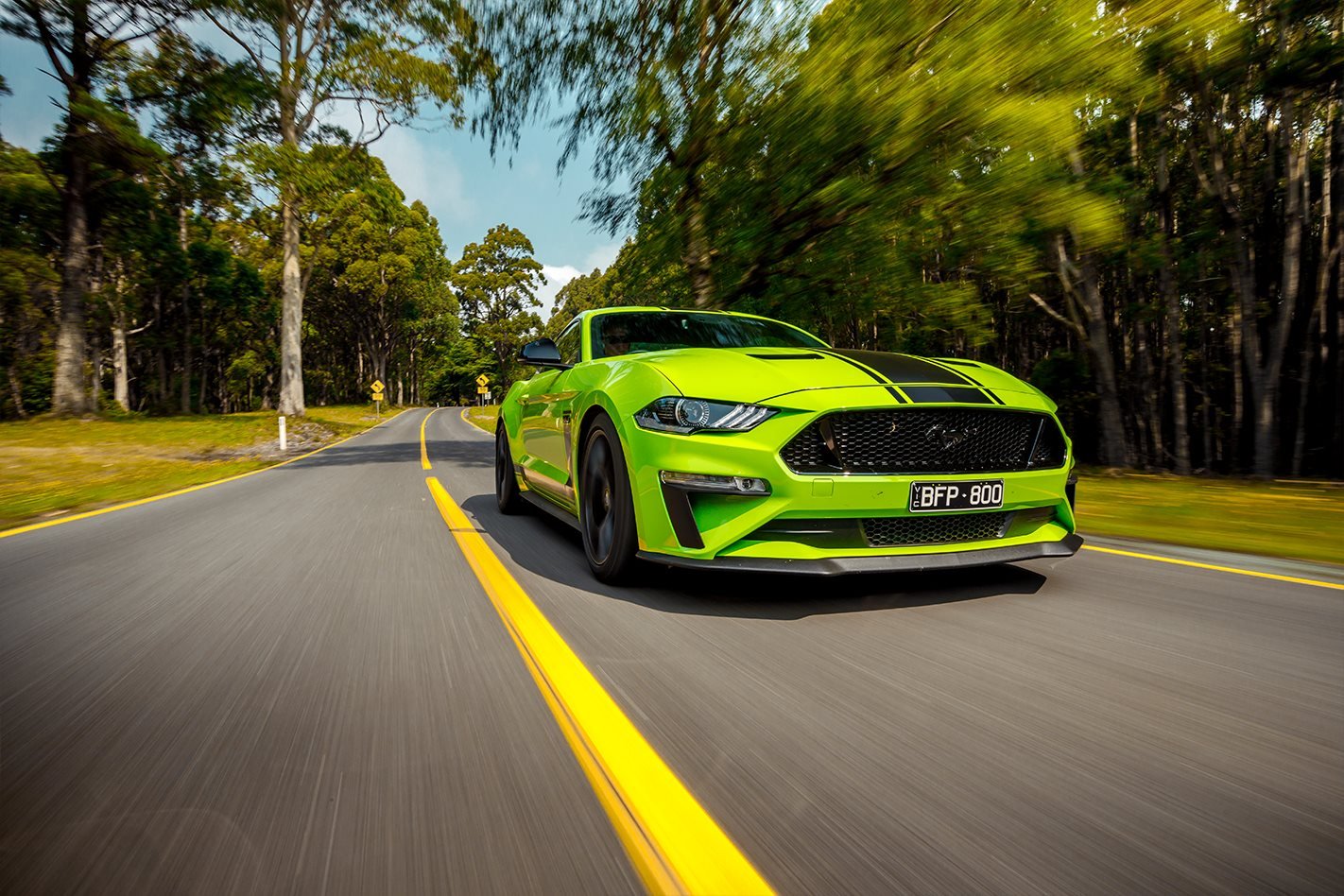Confession. I didn’t get much sleep the night before Wheels’ appointment with the Ford Mustang R-Spec. Perhaps it was the combination of it being build #001, the only one in existence and required at its own press launch a few days later, and the fact that my first acquaintance with it would be to put a helmet on and fire it down Heathcote’s strip, north of Melbourne, but I’ll freely admit to being a little bit spooked.
“We don’t have any power or torque figures for it yet,” said Ford’s Damion Smy, not exactly salving any apprehension. “Just don’t break it.” A cheery thumbs up and he was gone, leaving us with one of 2020’s most anticipated cars. Down-at-heel Heathcote’s never the most scenic of locations, but this Grabber Lime R-Spec looks the goods. Lowered by 20mm, and finished with contrasting black detailing and garnished with a stripe pack designed by designer Dave Dewitt, it looks vacuumed to the scabby bitumen, the Michelin tyres snuggling neatly into the arches.
Developed in collaboration with Herrod Performance, the R-Spec is priced at $99,980. For the premium of $36K over a regular Mustang GT coupe, the extras include a Roush-sourced Eaton R2650 TVS supercharger, a revised intake manifold with air-to liquid intercooler, a Borla quad-tip exhaust that satisfies Aussie drive-by noise regulations, wider wheels, uprated springs, beefier anti-roll bars and recalibrated MagneRide dampers.

What haven’t changed are the tyres. An estimated 47 percent increase in power is sent through the same 275/40ZR19 Michelin Pilot Sport 4S rear boots as the stock Mustang GT. To put that into some sort of perspective, they’re narrower than a Camaro ZL1’s front rubber. This has a fairly predictable effect. The R-Spec is as hard as hell to launch cleanly.
We’re limited in the amount of abuse we can ladle out to the car at the strip, but it’s clear that there’s a knife-edge sliver between bogging down and cremating the rear treads. Being offered in manual guise only, the R-Spec has no fire-and-forget launch control facility, and after a few runs, the best we manage is 4.7 seconds to 100. The trap speed at 400m tells a different story, though, the R-Spec galloping through at a heady 199.3km/h with an ET of 12.5 seconds. That is exactly the time Rob Herrod predicted we’d see.
“In absolutely optimum conditions, you can get it down to 12.2 seconds with the manual car,” he says, highlighting a technique espoused by Evan Smith of Modified Mustangs and Fast Fords. It isn’t really something we’d subject our test cars to, as it involves lowering rear tyre pressures and so forth, but it’s certainly illuminating. On the subject of peak power, Herrod explains Ford’s reticence to quote a power figure. “We’ve never had the engine out and on an engine dyno,” he explains, this being Ford’s technique for quoting a definitive power figure. “There are certain things that are different with [the R-Spec] such as the exhaust manifold and calibration, but when we’ve put it on our hub dyno it routinely makes 440 to 460kW at the rear wheels,” he says.
Taking driveline losses into account, that tips the R-Spec just the right side of 500kW at the crank. “The right fuelling is absolutely critical though,” advises Herrod. “We standardise our figures with Shell V-Power 98 and we’ve seen figures 100kW down when poor-quality fuels have been used,” he notes. “The engine computer is critical and will reduce power to protect the engine if it detects low-octane fuels or overheating.”

The ECU’s certainly not retarding the power in this particular car. It ran from 160 to 200km/h on the strip in just 3.9 seconds. Some frame of reference? A Mercedes-AMG C63 S Coupe requires 4.6 seconds. A 991-gen Porsche 911 GT3 would be lineball, so yes, it’s seriously rapid. Then you realise that you’re sitting in a sub-$100K car and you shake your head. Price-comparative coupe rivals like the BMW M2 Competition (5.2sec) and the Alpine A110 (6.4sec) can’t get close. The thing is, both would smoke the Ford away from the line on a pretty consistent basis. As will an all-wheel-drive superhatch.
Once rolling, the R-Spec impresses. We’ve poured praise on the shift action of the six-speed manual in the past, and palming it around the gate is a joy. You don’t actually need to, because the engine is so tractable you can leave it in third and you’re covered for meaningful acceleration anywhere from 30 to 150km/h, but it’s fun to see if you can heel-and-toe half as well as Ford’s rev-matching function. Just don’t try to rush the shift to third.
The power delivery is almost undramatic in how linear and polished it is. I admit, that sounds crashingly blasé when we’re talking about a 500kW car, but it’s a testament to Herrod’s team. There is no discernible point in the power band where the supercharger decides to really get stomping. Plug it anywhere from 2500rpm to the redline at 7400rpm and you’re golden. Likewise, the engine note doesn’t really harden or make any noticeable step changes. A subsonic bass tone enters the cabin between 1000 and 2000rpm and from there it’s just a progressive change in pitch and volume. You do get a delightful cross-plane woofle at idle, though.
Some may be a little disappointed that it doesn’t surge and yell, but toning down the histrionics makes the R-Spec a far better road car. You could quite happily use this car as your daily driver. The MagneRide dampers have been recalibrated to support the shorter springs. Being able to separate ride, throttle and ESC settings in a custom mode would have been welcome but Ford’s drive mode selector that runs through Normal, Sport+, Racetrack, Drag Strip, and Snow and Wet will usually have you covered.
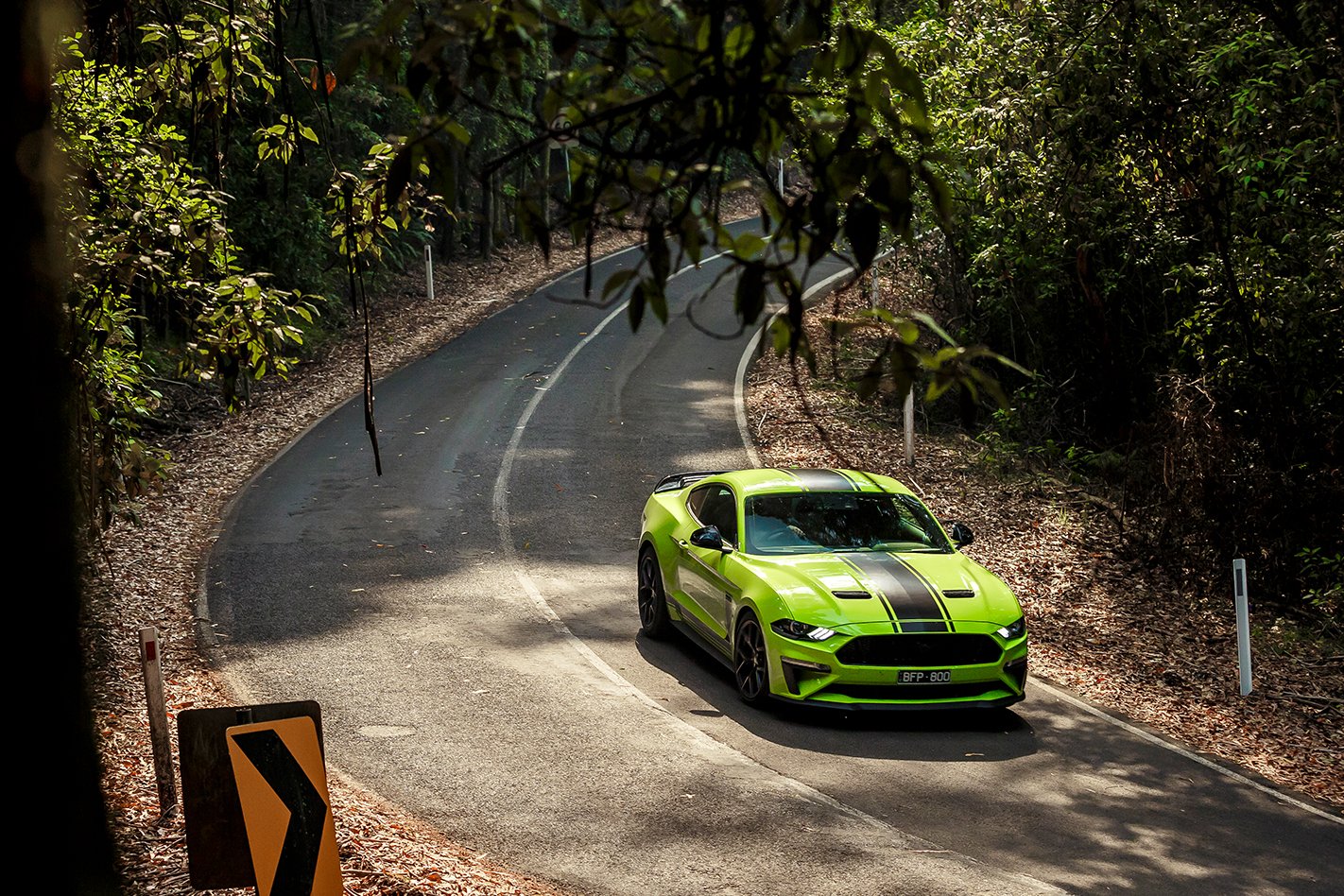
The steering isn’t overly chatty, but feels reassuringy direct on turn-in. The wheel will also give abundant warning of any incipient understeer, a high-frequency vibe transmitting through the agreeably slim rim as the front treadblocks start to wave the white flag. Delivering all that power on the go can tax the traction control system, which is effective if a little coarse in its sound signature.
We’ve come to think of the Mustang as a bit of an affable lump that requires a slow hand to manage its relaxed body control. The R-Spec is a far more focused proposition. It sits flat and corners hard with a strong front end and enough travel in the throttle pedal not to make pouring on power after the apex a heart-in-mouth activity. Upping the anti-roll bar gauge can have the effect of neutering feedback, but the R-Spec telegraphs its intentions clearly. It’s a classy piece of chassis tuning.
On a typically gnarly Aussie B-road, it bumps, thumps and jostles, but will commit to a line and hold its poise doggedly. Only at genuinely inadvisable velocities does it start to feel a bit live, first getting up on its toes and, should you push still further, reminding you of the limits of its suspension travel. There’s a tactile delight in slipping into the generously cut Recaros, peering down that long bonnet and teasing the car’s limits of grip, brapping up and down the ’box just for the fun of it. Yes, you could identify all manner of cars that might well be going more quickly, but few that reward the driver with such big-hearted generosity. Certainly not at less than a hundred grand.
Our drive route takes us from Heathcote south to Mount Macedon. The roads here dive deep into shadowy eucalypt forests, tree roots putting massive bumps onto corner apexes. If anywhere can show up deficiencies in the R-Spec’s corner carving ability, it’s these raddled hairpins. Yet there’s none of that tedious tapdance on the throttle that you get with a poorly set-up calibration. Even under severe provocation, you can ladle on just the right amount of power. Build your confidence and it’s possible to nudge the back about on the gas fairly easily but you’re always aware that 1700kg-plus can wield a considerable serving of angular momentum.
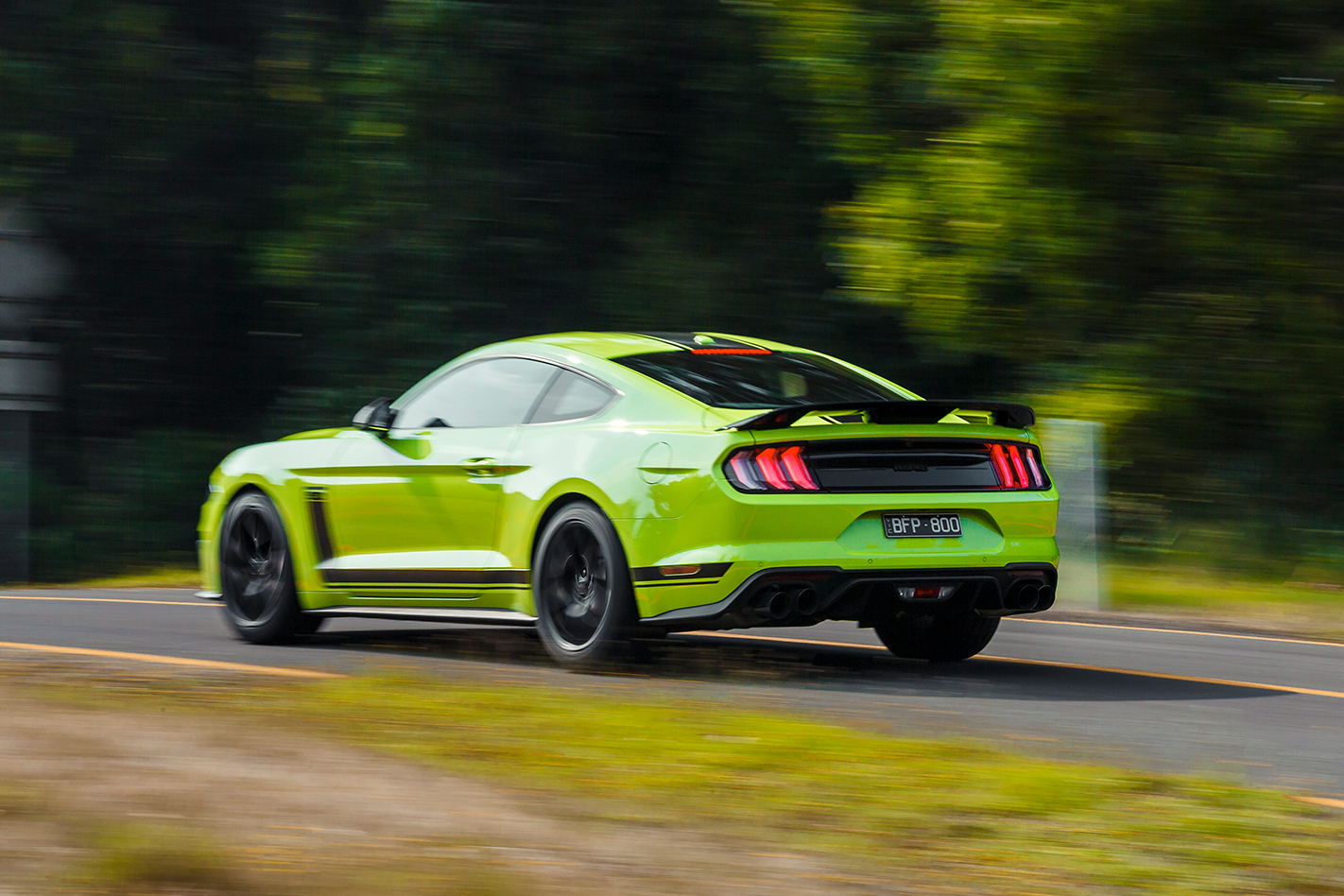
The Brembo brakes should also be singled out for special mention. They’re carryover items from the Mustang GT but pedal feel is excellent and the 33.8m braking performance from 100km/h is wholly respectable for such a hefty beast.
About the biggest compliment it’s possible to give the R-Spec is that it feels completely factory. It’s an almost perfect interpretation of the Mustang V8 amplified. The slightly vague boofiness that afflicts the standard GT has been excised, replaced by a surgical steeliness. It’s not perfect, though. It needs wider rubber at the back, as Ford Performance’s recommended wheel and tyre for this car feels malnourished. Imagine a Mustang GT on a set of Michelin Primacy HPs from a Toyota 86 and you get the idea. The Pilot Sport 4S is a lovely tyre, but it’s ultimately overmatched here, constrained by simple physics.
That aside, it’s hard to find fault, especially at this price. Accept that it’s no stoplight hero and there’s a lot to love about the Mustang R-Spec. It’s a vehicle that’s been developed with care and ingenuity, and which credits its operator with a bit of nous. That’s not always the case in a muscle-car market where the big number is often all that counts. In hindsight, I shouldn’t have lost sleep over driving it. As Smy comes to relieve me of the keys a couple of days later, I’m preoccupied with a different anxiety. When do I get to drive the R-Spec again? It doesn’t last, instead being replaced by an almost embarrassing sense of pride at a simple but grin-inducing fact: Australia might just have helped build the world’s loveliest Mustang.
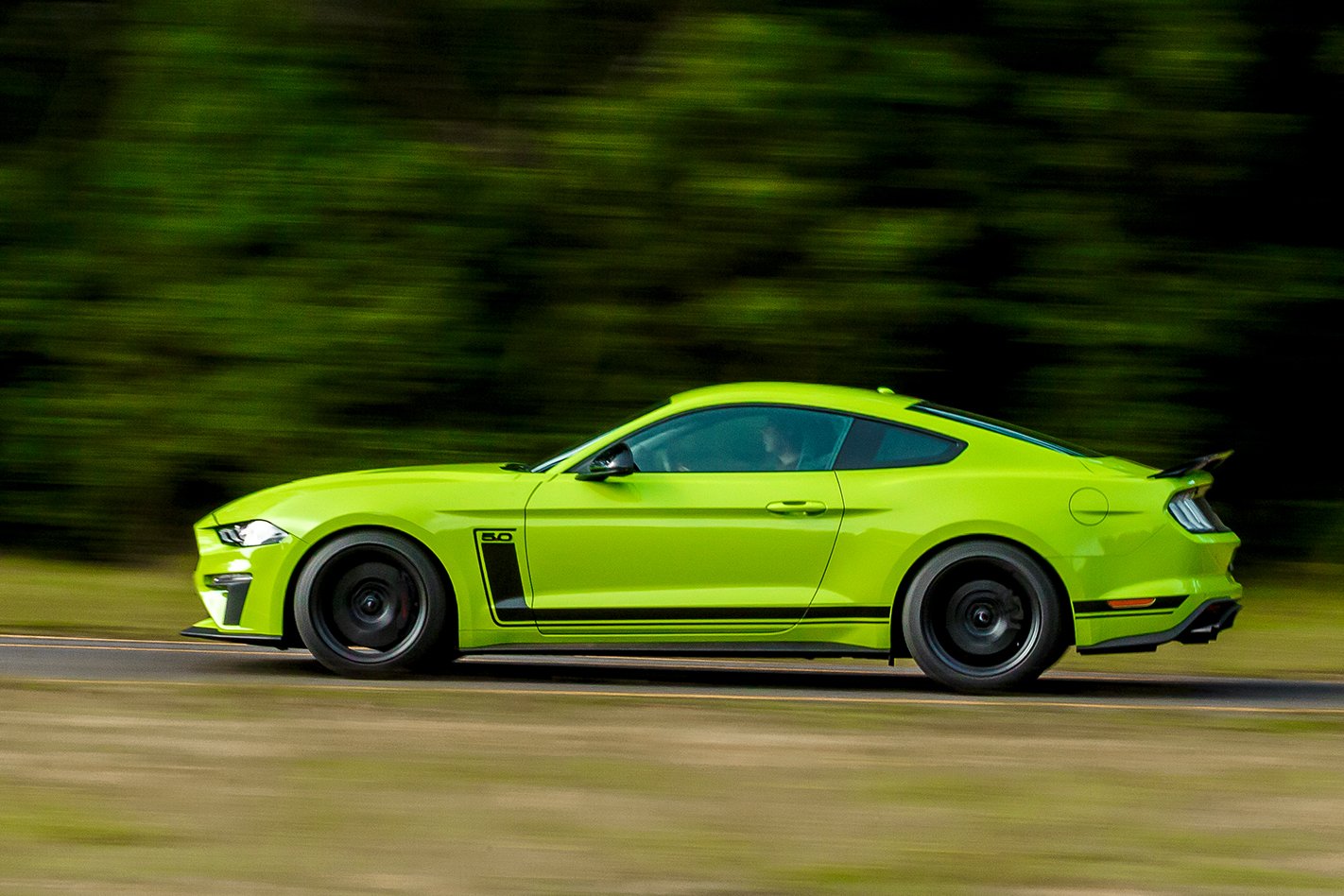
What about the Shelby?
As potent as it may be, the Mustang R-Spec isn’t the biggest-calibre gun in Ford’s arsenal. The seven-speed dual-clutch Shelby GT500 packs a full 522kW quota from its supercharged hand-built 5.2-litre donk, but isn’t built in right-hand drive. To get one of these in Australia, you’d need to get in touch with Mustang Motorsport. One of their locally converted right-hookers will set you back an estimated $245,000.
Postscript: the hot take
After we tested the R-Spec, our colleagues across the aisle at MOTOR had a crack. While they were able to emulate our 4.7sec 0-100 sprint on one aborted run, 400m trap speeds were about 10km/h down on ours. The reason? The ECU appeared to be protecting the engine by cutting peak power on a far hotter day. It seems the Aussie R-Spec prefers cool mornings.

Ford Mustang R-Spec specs
Engine: V8 (90°), dohc, 32v, supercharged
Layout: front engine (north-south), rear drive
Capacity: 5038cc
Power: 500kW (estimated)
Torque: 827Nm (estimated)
Trans.: 6-speed manual
Body: steel, 2 doors, 4 seats
L/W/H/W–B: 4789/1916/1367/2720mm
Track (F/R): 1618/1636mm
Weight: 1710kg
Boot: 408 litres
Fuel/tank: 91 octane/61 litres
Economy: 15.9L/100km (test average)
Front suspension: struts, A-arms, adaptive dampers, anti-roll bar
Rear suspension: multi-link, coil springs, adaptive dampers, anti-roll bar
Steering: electric rack and pinion
Turn circle: 12.2m (2.5 turns lock-to-lock)
Front brakes: ventilated discs (380mm)
Rear brakes: ventilated discs (330mm)
Tyres: Michelin Pilot Sport 4S
Tyre size: 255/40ZR19 100Y (f); 275/40ZR19 105Y (r)
ANCAP rating: not tested (Aus)
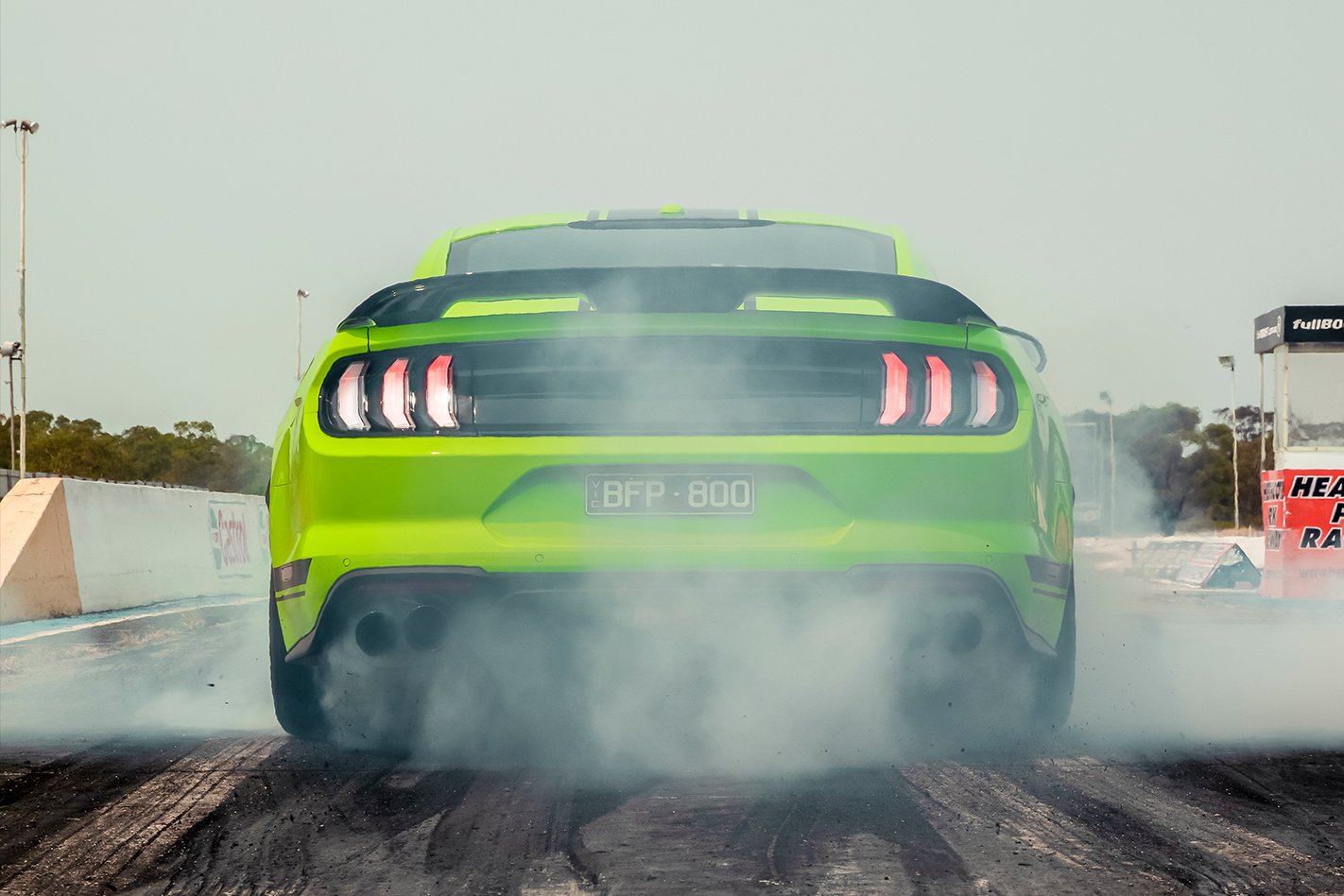
Ford Mustang R-Spec performance figures
- Power-to-weight: 292kW per tonne (est)
- Redline/cut-out: 7400/7400rpm
- Speed at indicated 100km/h: 96
- 0-20km/h: 0.9sec
- 0-40km/h: 1.7sec
- 0-60km/h: 2.8sec
- 0-80km/h: 3.7sec
- 0-100km/h: 4.7sec
- 0-120km/h: 5.9sec
- 0-140km/h: 7.3sec
- 0-160km/h: 8.6sec
- 0-180km/h: 10.4sec
- 0-200km/h: 12.5sec
- 0-400m: 12.4sec @ 199.1km/h
- 80-120km/h: 2.8sec
- 100km/h-0: 33.8m


